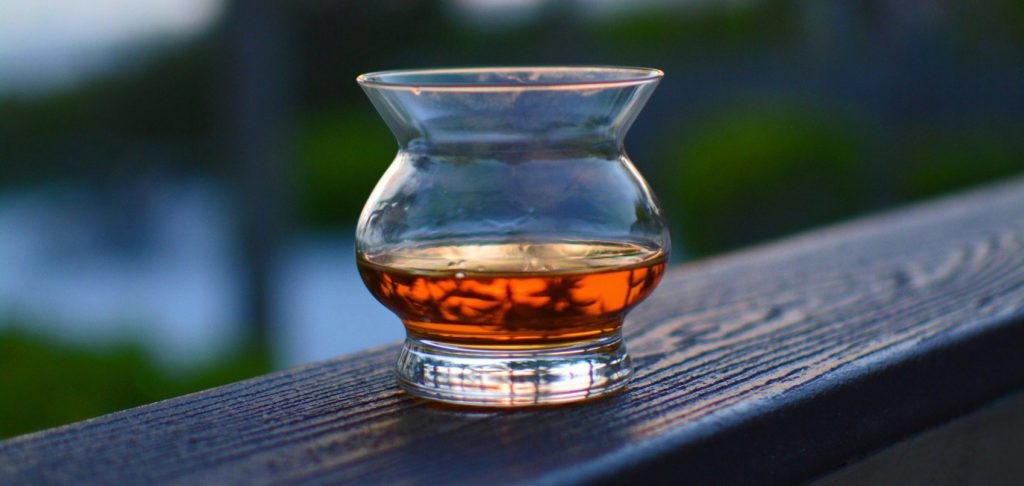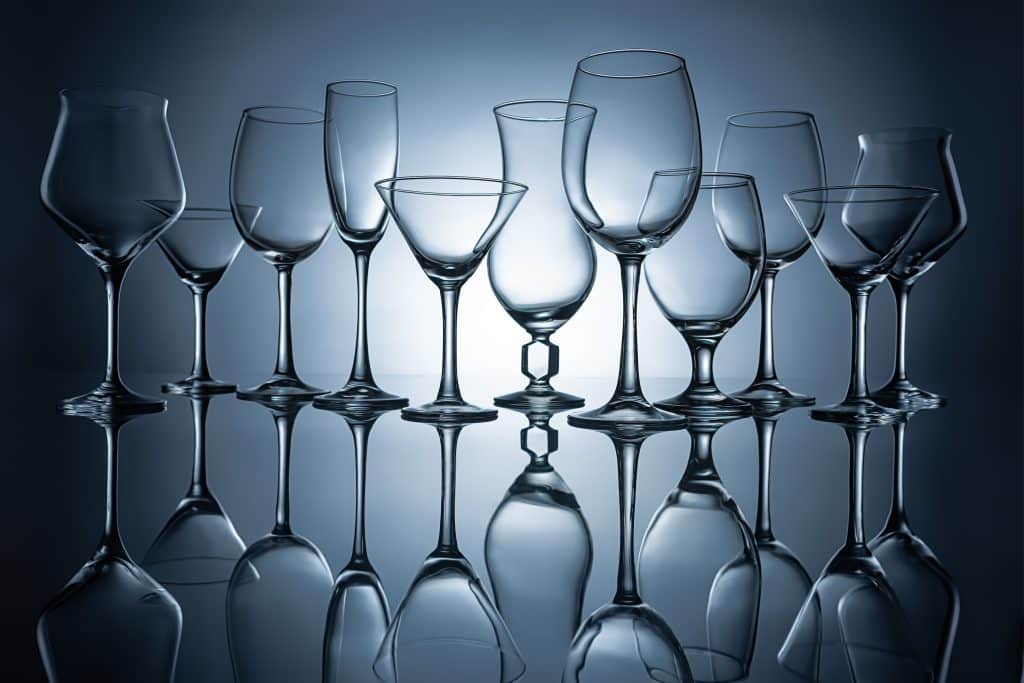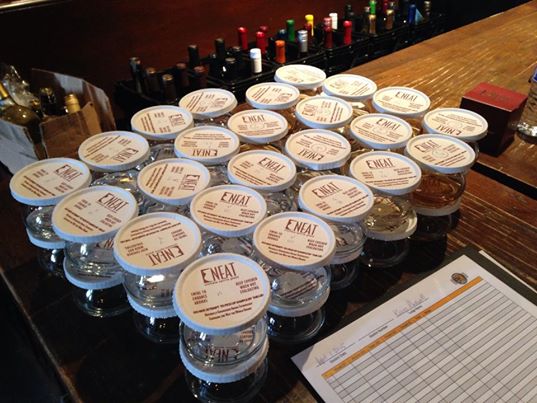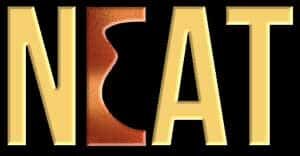

Numb Noses Ruin the Tasting Experience and Increase Dependency
George F Manska, CR&D Arsilica, Inc.
First, we want to thank all of you who subscribe to NEATNEWS. Our objective is to put whiskey tasting (and all other spirits for that matter) in the perspective of science.
In our last two NEATNEWS letters, we allude to the behavior of tasting event attendees and the different types of personalities of whiskey tasters. Basically, no one gets any useful information, largely because procedures, glassware, and primary emphasis on what is important all work against true science. It seems whiskey drinkers are just playing at tasting, and few are serious.
The Glass is the Problem: The decades-long usage of a glass designed for 16-22% ABV sherry copita/tulip to taste 40% ABV spirits places an invisible barrier to a deeper understanding of whiskey or any spirit. Ethanol anesthetizes olfactory neuron receptors from the very first sniff. This barrier is anesthetic ethanol alcohol. Tulips create a nose-bomb of pungent numbing ethanol, hiding subtle flavors. As a result, drinkers seldom if ever get an accurate picture of a spirit’s true profile.

Ethanol is Also the Problem: We love ethanol, don’t we? As a matter of fact, euphoric ethanol is the major reason we drink. Yet we are just kidding ourselves with the tastings, events, and machinations we put ourselves through. We use those as excuses to get a sip of ethanol, not to learn more about the spirits.
Tulips in combination with the public’s long-ingrained worship of pungent, nose-numbing, anesthetic ethanol places the ethanol barrier to knowledge and understanding, directly between drinker and spirit. To clarify, we truly understand very little about the spirit, because ethanol keeps us in a nose-numbed fog.
Why ethanol is not a problem in wines: Evaluation and pinpointing flavors is much easier with wines, which have lower ethanol, ranging from 4-16%. With a little practice, almost anyone can easily tell the difference between grape varietals. Additionally, they can detect slight differences in style. For example, monitoring pH, temperature, and using inoculation of cultured bacteria promotes buttery-flavored malolactic fermentation. As well, easily detected oxidation is desirable in some red Spanish wines.
The Difference is Low Ethanol: Because the low ethanol in wine does not quickly nor totally interfere with our olfactory and chemosensory receptors, it gives us a little time to detect, identify, and differentiate the flavors. In our estimation and experience with wines, a much higher percentage of wine drinkers know and understand wines. The percentage of spirits drinkers who can differentiate and even identify different spirits is much lower.
Why We Seek Outside Opinions: Why do so many bloggers, critics, gurus, and book authors exist to tell us about what is good and what is not? We think it’s because the ingrained pre-disposition to pungent ethanol makes ethanol the end game. Everything else stops at that first whiff of the drug ethanol. Consequently, there is no continuation to discover subtle sensations, nose, and flavors of the spirit. Therefore, after a drink or two we need to ask someone else’s opinion or read tasting notes. Nose-numbed, it’s the only way to discover which flavor notes we should remember.
Try this Observation: Stand in the aisle of the liquor store and watch how consumers choose. Many already know the bottle/label/package they came to buy. They can walk directly to it, pick it up without reading the label and head for checkout.
Those who are trying to make up their minds will spot the eye candy of an attractive label or bottle and pick it up to read the label. Upon examination, they find the Proof or ABV and note the price. To clarify, they use these visible signs to quickly calculate their perception of value (Cost divided by %ABV).
Motivations: Proof, appearance, and well-advertised names sell spirits. However, flavors, aromas, and quality have nothing to do with most choices. As a result, alcohol has become the invisible, painless barrier to understanding.

Who Ya Gonna Call? In order to find more information, some go to the phone, click on their favorite app or blog site, and buy (or not) by the rating. Some consult well-known evaluators’ notes. Approach them and ask how they make their buying decisions. The answers are astonishing. Most spirits buyers consult someone else to help them make purchasing decisions, usually through the inconsistent ratings number game or known blogger gurus’ opinions. Why do more spirits buyers consult others to help them make their decision? It’s simple:
Costly Errors in Judgment: Spirits are priced higher than wine, so disappointment is more costly, getting another opinion can reduce purchase regrets.
Average Knowledge Level: There are neophytes in both spirits and wine. Yet wine discussions are more in-depth and occur more often than spirits, so general knowledge may be greater among wine drinkers than spirits drinkers.
Ethanol is the Major Problem: The invisible nose-numbing ethanol barrier limits the average drinker’s ability to evaluate, catalog, and build a smell library of flavors. Those processes are multiplied by tulip glasses which deliver ethanol and hide aromas. As a result, flavors and aromas are masked. Therefore, there isn’t much available to learn.
Who can you trust? At the level of nose numbing that occurs from tulip-shaped glasses, very few critics and evaluators are endowed with good noses. Most do not understand basic science. Few ever practice building a personal memory library of aromas and flavors to be truly accurate evaluators of spirits. Therefore, few are actually qualified to give advice. Consequently, it’s all up to you to develop your own sensory.
Find the Good Guys: There are plenty of good noses and honest evaluators out there. The challenge is finding them. We prefer those who taste blind, with someone else preparing the samples blind, using triangle testing, and verifying more than once in different orders. More than a few do not use tulip glasses.
Those in the business of providing tasting notes and public information need to know as much as possible. Those few evaluators who do understand the effects of ethanol work hard to keep the ethanol cloud from affecting their notes.
Get Rid of the Non-functional Glass: The reluctance of evaluators and drinkers to part from the tulip glass is strong. They may know other alternatives to improve detection, identification, and differentiation of aromas and flavors. Common excuses not to change include:
– “I believe the smell of ethanol belongs with the spirit and should not be separated.”
– “I have a good nose and the ethanol doesn’t bother me.”
– “Everyone else drinks from tulips and I need to evaluate from tulips as well to relate to the drinkers.”
Let’s discuss each one to expose the fallacy of not thinking the problem through.
Ethanol belongs: Tolerating ethanol aromas from tulips is essentially the same as agreeing that ethanol ruins the sense of smell. “But that’s okay; I don’t care if I can’t detect the subtle flavors in the spirit. Everyone else does it.” Back in the real world, who in their right mind wants to limit their sensory abilities?
Good Nose: Sorry Charlie, you had a good nose until you snorted ethanol It doesn’t bother anyone because there is no warning.
You Don’t Have to Be “Everyone Else.” Ethanol gives no warning. Every time ethanol molecules attach to cilia (tiny hairs located in the epithelium), the olfactory receptor neuron connected to the hair (cilium) is rendered useless. If the aromas are 40%-ethanol, 4%-character aromas, and 56%-air, most neurons that can detect aromas are canceled by ethanol. Most importantly, ethanol doesn’t consciously bother us once we get past initial pungency. However, ethanol still numbs ORNs regardless of awareness or comfort.
Competitions Have Their Problems: Inquisitive consumers also seek and review competition medals and ratings to help purchase spirits. This practice comes directly from wine. Wine rating systems and tasting notes are made with a much higher understanding of attributes, flaws, etc. than spirits. However, the main purpose of many competitions is to gather revenues and comprehensive notes seldom exist. In addition, many other factors work against competition’s integrity and accurate evaluation. Here are a few simple issues:
Who is to Judge? Personalities in the industry or entertainment, or business associates, vendors, and distributors who have personal relationships with competition organizers become judges. Most have no concept of fair judging.
Personal Bias: Most judges cannot separate personal opinion from judging and are not fair to spirits they don’t like.
Flight Size: Pushing flights of six or more samples for evaluation in 45 minutes with nose-numbing tulip glasses lowers the judges’ ability to detect, identify, and discriminate flavors. The distiller whose product is last in the flight, has a disadvantage, especially if it is a high-quality expression that cannot be appreciated by numbed noses.
Logistics: Many times, tasting scorecards and composition of flight samples have no organization. Many samples are judged in a peer sample environment (flight) in which their style is distinctively different, possibly raising a concern that the different one is not like the others and should deserve a lower rating.
In short, there are a lot of good, reliable competitions out there, who do it right. However, you must research to find them. BTW, NEAT is the official judging glass of over 40 major international competitions annually, and we consult many competitions. NEAT lets you have it both ways. First, evaluate the glass rim. Then, if you really miss pungent ethanol, stick your nose into the glass to the neck plane. Tulips give you no option other than hunt and peck, and sniffing around in a race to see if you can determine the flavors and aromas before your nose gets numb.
In Summary: There’s much we have not covered. If you are serious, build your own knowledge, trust yourself, and move beyond the barrier that stops 90% of spirits drinkers from being knowledgeable. Subsequently, you will reward yourself with greater understanding.
Be inquisitive about the process, barrels, and distillation processes. Note how all these things relate to your own sensory enjoyment. It is nearly impossible to achieve a high level of understanding with tulip glasses.
In conclusion, education begins at home by learning to trust your senses. Finally, it progresses further with a better glass. Click for more.

Note: Enrolled NEATNEWS subscribers are entitled to 10% discount on all purchases and free
shipping over $55 for as long as you are enrolled. Coupon code: ILUVNEAT
Bio: George F Manska, CR&D, Arsilica, Inc.
Qualifications: Published sensory science researcher, entrepreneur. BSME, NEAT glass co-inventor
Mission: Replace myth and misinformation with scientific truth through consumer education.
Comments Welcome – Contact: george@arsilica.com, phone 702.332.7305.
More Information: www.theneatglass.com/shop

